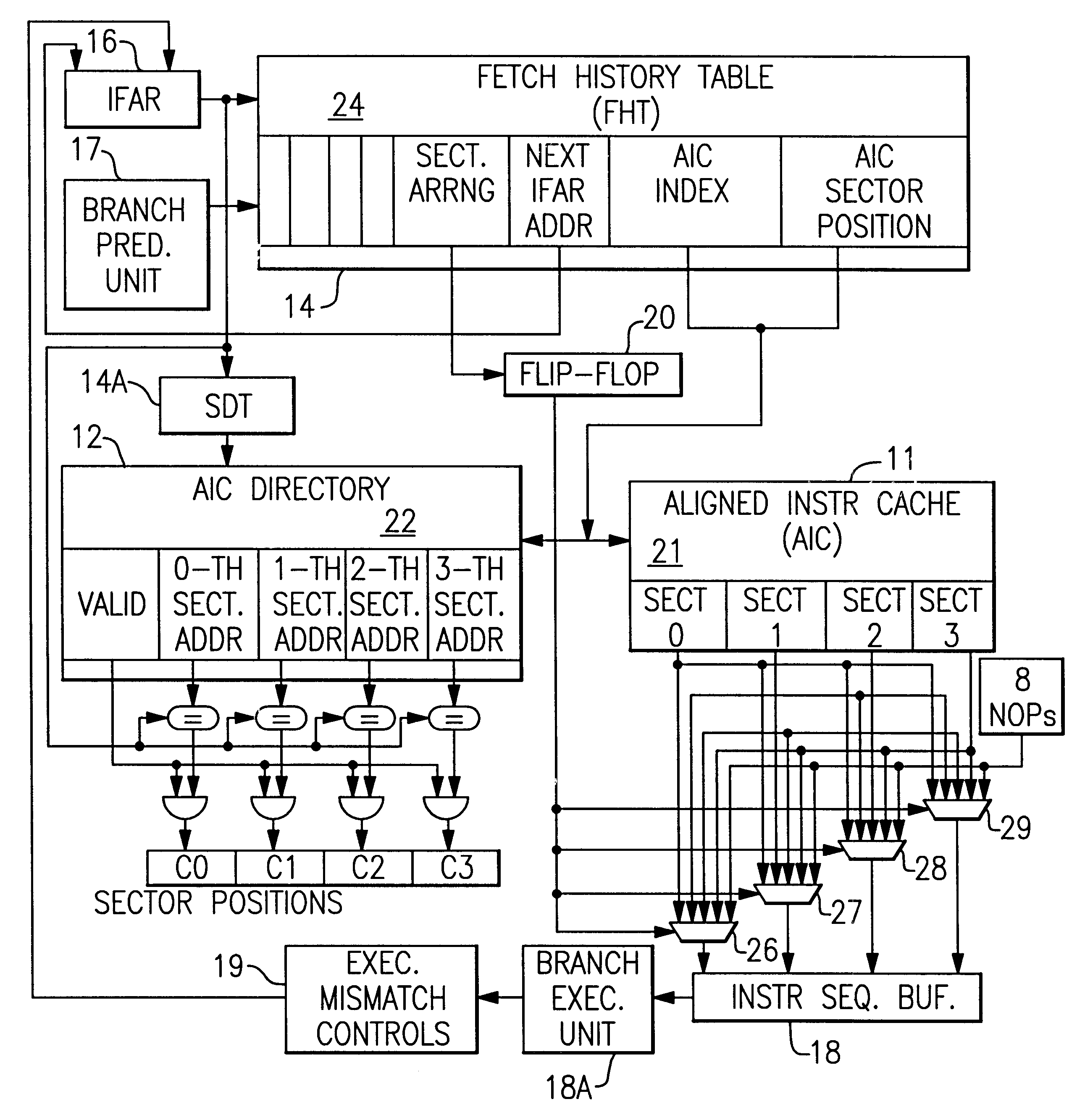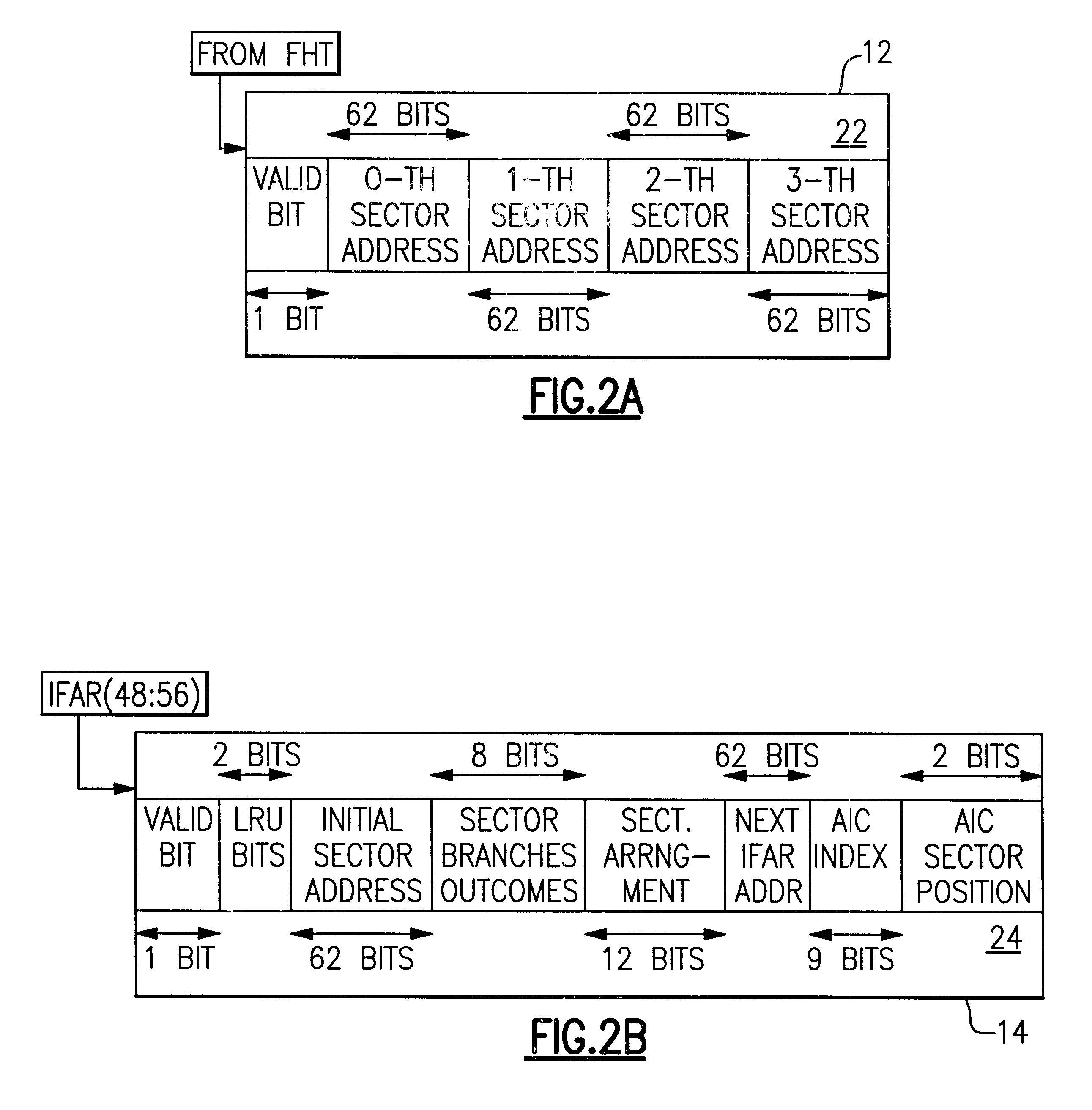Total flexibility of predicted fetching of multiple sectors from an aligned instruction cache for instruction execution
a technology of instruction execution and total flexibility, applied in the direction of computation using denominational number representation, memory adressing/allocation/relocation, instruments, etc., can solve the problem of not preventing a fht miss
- Summary
- Abstract
- Description
- Claims
- Application Information
AI Technical Summary
Benefits of technology
Problems solved by technology
Method used
Image
Examples
example 1
may be summarized as follows:
Example 2 has a sequence of consecutive FHT cycles for providing instructions for executing a loop, involving use of different FHT entries in the same FHT set. Only cycles 1, 2 and 3 need to be explained in detail, since its following cycles in the loop are repetitions of cycles 1, 2 and 3. This example begins with a current prediction providing a current IFAR address, W, and a prediction vector, 0101001010101 . . . . Cycle 1 uses the current IFAR address, W, to access FHT set 36, which has a FHT hit in FHT entry 36B, since V matches the "initial IFAR address" field in FHT entry 36B, and the first two prediction bits, 01, match the *01* "arrangement" field in FHT entry 36B. FHT entry 36B selects AIC row "c" as its associated row, and indicates sector position 0 as the first sector to be outgated in the specified sector sequence 0, 1, 2, 0 in its "arrangement" field which specifies sectors W, X, V, W for being outgated from AIC row "c" for execution in th...
example 2
may be summarized as follows:
The third and final example given herein is a more complicated example of a loop using multiple AIC rows, instead of all cycles accessing the same AIC row, as is done in example 2. The consecutive FHT cycles of example 3 also provide a sequence of instructions for executing a loop. Example 3 starts with a current prediction of: an "next IFAR address" of U, and a prediction vector bit sequence having bits 0110011001100110. Each cycle only uses the leftmost vector bits unconsumed by a prior cycle; each cycle consumes the vector bits matching any branch-instruction bits in its FHT "arrangement" field. Only cycles 1, 2 and 3 need to be explained in detail, since its following cycles 4, etc. repeat the loop cycles 1, 2 and 3. Example 3 begins with its cycle 1 using the current IFAR address, U, (containing an "IFAR set number" field that accesses FHT set 34), and matches address U to the "initial IFAR address" field in each FHT entry in set 34. When matching i...
example 3
may be summarized as follows
Note that some of the FHT entries in the FHT sets 34, 35 and 36 specify sequences that do not start with a first sector position, 0, in an associated AIC row. It is a novel characteristic of this invention that any FHT entry's outputted sector sequence may start with any sector in the associated AIC row. Any of the FHT specified sector sequences are allowed to branch within the specified AIC row either backward (from right to left) or forward (from left to right) within the AIC row. Thus, in the FIG. 3 examples AIC rows "a" and "b" illustrate forward branching within the associated AIC row, and AIC rows "c" illustrates backward branching within its associated AIC row. Any AIC row may have one or more branch instructions capable of branching outside of its AIC row, as is illustrated by AIC rows "a" and "b".
PUM
 Login to View More
Login to View More Abstract
Description
Claims
Application Information
 Login to View More
Login to View More - R&D
- Intellectual Property
- Life Sciences
- Materials
- Tech Scout
- Unparalleled Data Quality
- Higher Quality Content
- 60% Fewer Hallucinations
Browse by: Latest US Patents, China's latest patents, Technical Efficacy Thesaurus, Application Domain, Technology Topic, Popular Technical Reports.
© 2025 PatSnap. All rights reserved.Legal|Privacy policy|Modern Slavery Act Transparency Statement|Sitemap|About US| Contact US: help@patsnap.com



